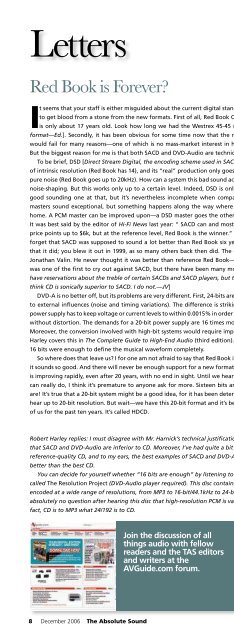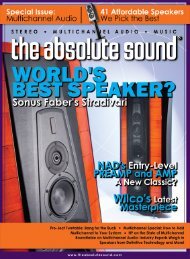Create successful ePaper yourself
Turn your PDF publications into a flip-book with our unique Google optimized e-Paper software.
Letters<br />
Red Book is Forever<br />
It seems that your staff is either misguided about the current digital standard or that you expect<br />
to get blood from a stone from the new formats. First of all, Red Book CD—the “aging format”<br />
is only about 17 years old. Look how long we had the Westrex 45-45 standard [the stereo LP<br />
format—Ed.]. Secondly, it has been obvious for some time now that the new “high-res” formats<br />
would fail for many reasons—one of which is no mass-market interest in higher-fidelity software.<br />
But the biggest reason for me is that both SACD and DVD-Audio are technically handicapped.<br />
To be brief, DSD [Direct Stream Digital, the encoding scheme used in SACD—Ed.] has only six bits<br />
of intrinsic resolution (Red Book has 14), and its “real” production only goes up to 8kHz—the rest is<br />
pure noise (Red Book goes up to 20kHz). How can a system this bad sound acceptable By aggressive<br />
noise-shaping. But this works only up to a certain level. Indeed, DSD is only half a format—a very<br />
good sounding one at that, but it’s nevertheless incomplete when compared to Red Book. DSD<br />
masters sound exceptional, but something happens along the way where they come up short at<br />
home. A PCM master can be improved upon—a DSD master goes the other way. The bottom line<br />
It was best said by the editor of Hi-Fi News last year: “ SACD can and mostly does sound better at<br />
price points up to $6k, but at the reference level, Red Book is the winner.” This is so true. Let’s not<br />
forget that SACD was supposed to sound a lot better than Red Book six years ago. Some thought<br />
that it did; you blew it out in 1999, as so many others back then did. The exception was good ol’<br />
Jonathan Valin. He never thought it was better than reference Red Book—thank God for him. He<br />
was one of the first to cry out against SACD, but there have been many more since. [I did and do<br />
have reservations about the treble of certain SACDs and SACD players, but that doesn’t mean that I<br />
think CD is sonically superior to SACD. I do not.—JV]<br />
DVD-A is no better off, but its problems are very different. First, 24-bits are much more susceptible<br />
to external influences (noise and timing variations). The difference is striking. In a 16-bit system a<br />
power supply has to keep voltage or current levels to within 0.0015% in order to realize full resolution<br />
without distortion. The demands for a 20-bit power supply are 16 times more stringent—0.0001%.<br />
Moreover, the conversion involved with high-bit systems would require impossible accuracy. Robert<br />
Harley covers this in The Complete Guide to High-End Audio (third edition). It was always true that<br />
16 bits were enough to define the musical waveform completely.<br />
So where does that leave us I for one am not afraid to say that Red Book is forever. Why Because<br />
it sounds so good. And there will never be enough support for a new format to replace it. Besides, it<br />
is improving rapidly, even after 20 years, with no end in sight. Until we hear what this “old format”<br />
can really do, I think it’s premature to anyone ask for more. Sixteen bits aren’t enough Yes, they<br />
are! It’s true that a 20-bit system might be a good idea, for it has been determined that humans can<br />
hear up to 20-bit resolution. But wait—we have this 20-bit format and it’s been sitting right in front<br />
of us for the past ten years. It’s called HDCD.<br />
John Harnick<br />
Robert Harley replies: I must disagree with Mr. Harnick’s technical justification for concluding<br />
that SACD and DVD-Audio are inferior to CD. Moreover, I’ve had quite a bit of experience with<br />
reference-quality CD, and to my ears, the best examples of SACD and DVD-A sound significantly<br />
better than the best CD.<br />
You can decide for yourself whether “16 bits are enough” by listening to a remarkable disc<br />
called The Resolution Project (DVD-Audio player required). This disc contains musical pieces<br />
encoded at a wide range of resolutions, from MP3 to 16-bit/44.1kHz to 24-bit/192kHz. There’s<br />
absolutely no question after hearing this disc that high-resolution PCM is vastly better to CD. In<br />
fact, CD is to MP3 what 24/192 is to CD.<br />
Join the discussion of all<br />
things audio with fellow<br />
readers and the TAS editors<br />
and writers at the<br />
AVGuide.com forum.<br />
The following letters<br />
were sent directly to HP’s<br />
Workshop. I have edited<br />
some of them without<br />
the usual indications of<br />
deleted materials. Believe<br />
me, nothing “tough”<br />
went out. —HP<br />
The Real Thing<br />
and Sonic Criteria<br />
HP:<br />
…I found the analysis of the digital domain the<br />
August issue of The Absolute Sound particularly<br />
interesting. I’d like to know the criteria you<br />
used for you selection of digital sources—e.g.,<br />
there is no Wadia, DCS, Meitner.<br />
Another point of interest is the choice of<br />
music. I am particularly interested in classical<br />
music. I will buy an “audiophile” recording if<br />
I consider the performance to be, in musical<br />
terms, of the highest quality. Interestingly, and<br />
this applies to all the main high-end magazines,<br />
sometimes audiophile recordings used in<br />
reviews may not be what are generally regarded<br />
as amongst the best performances of a piece in<br />
musical terms. Often top orchestras—the likes<br />
of Berlin, Vienna, London, Chicago—are not<br />
represented. As an aside, might I say that your<br />
choice of material for the digital review certainly<br />
comprised top musical performances, at least<br />
of the more vintage variety. Whilst there may<br />
be some sense in using audiophile recordings<br />
to illustrate the qualities of equipment, is there<br />
not an argument in musical terms for using<br />
the most critically acclaimed performances,<br />
even if they do not always “sound” the best I<br />
have decided to renew my subscription to The<br />
Absolute Sound based on your Workshop and<br />
The Cutting Edge.<br />
Warren Gordon<br />
I gather you are asking my criteria for excluding the<br />
Wadia and DCS. The Meitner multichannel SACD<br />
gear I have commented upon at some length. I<br />
really don’t have a rule of thumb for reviewing<br />
components. In this instance, I picked those digital<br />
devices that I thought were either at the cutting<br />
edge of playback or approaching that in more<br />
modestly priced units. Much of this is intuitive on<br />
my part. I am not trying to find “representative”<br />
products. Nothing could interest me less.<br />
The recordings you use depend on the kind of<br />
review you are writing. Obviously, a record from a<br />
major label using a world-class orchestra does not,<br />
these days, guarantee a superior interpretation,<br />
and all too seldom a lifelike sound. Few music-<br />
December 2006 The Absolute Sound










